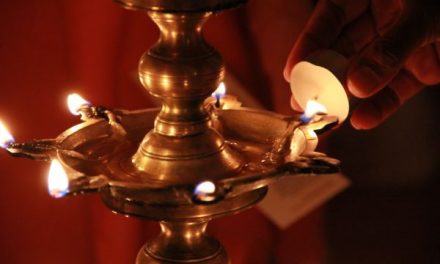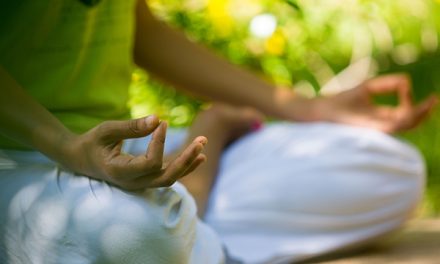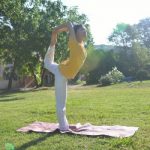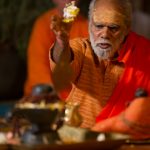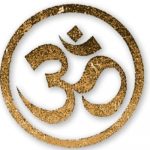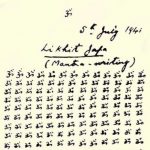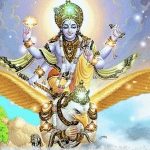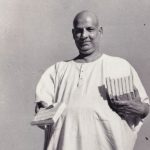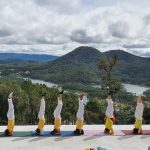 LIKITA JAPA
LIKITA JAPA
A PRACTICAL WAY OF MEDITATION
BY SWAMI JYOTIRMAYANANDA
“A mantra is a mass of radiant energy. Every mantra has got tremendous force. It helps the spiritual power and reinforces it.
– Swami Sivananda
The word ‘mantra’ is derived from the root man which means to think. Tra means to protect or to free and thus a mantra protects our own mind from negativity and frees it from the bondage of the illusory world. Mantras fill the mind with purity, improve concentration, generate harmony and divine love.
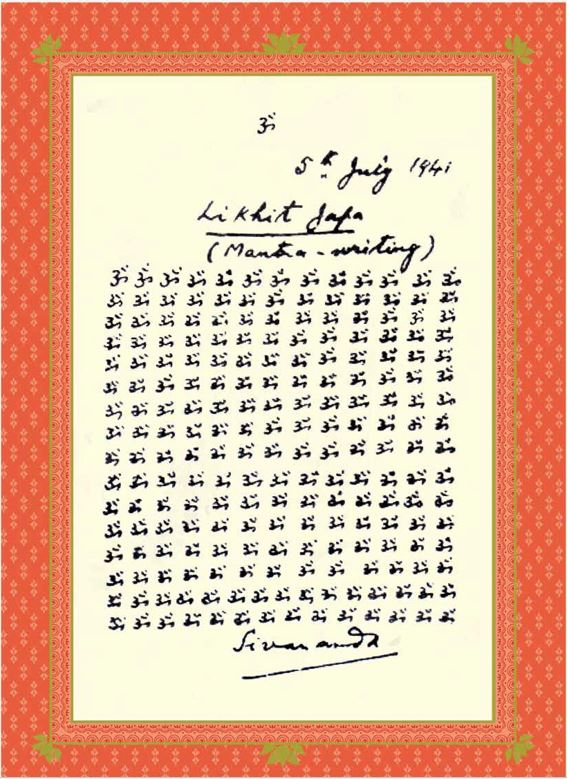 Methods of mantra meditation
Methods of mantra meditation
There are three ways to use the mantras:
• Mental repetition – repeating the mantra mentally in silence
• Verbal repetition – repeating the mantra aloud
• Likitha japa – writing the mantra
In the mental repetition of a mantra, the mantra is repeated in harmony with the natural rhythm of the breath. Mental repetition is considered a very powerful method and requires a concentrated mind.
In the verbal repetition of a mantra, the organ of speech is involved which makes it easier to keep the attention focussed.
External sounds are muffled when repeating a mantra aloud supporting the process of inner concentration further.
Likitha japa includes mental repetition of the mantra with the mind simultaneously reciting the mantra while writing. As the hands and the organ of sight are active in likitha japa, this method tends to concentrate the mind easily and efficiently.
There is no need to choose one method as a personal practice while excluding the other methods. You can use the three different ways of mantra meditation
alternately, according to the mantra practice that naturally draws you more at any given point. Providing variety to the mind helps concentration and keeps the practice fresh and inspired.
Likitha Japa
If you have received mantra initiation, then you can write your own personal mantra during likitha japa like Om, Soham, Om Sri Maha Ganapataye Namah, Om Namah Sivaya, Om Namo Narayanaya, Om Namo Bhagavate Vasudevaya, Om Sri Ramaya Namah, Om Sri Durgayai Namah, Om
Sri Maha Lakshmyai Namah, Om Aim Saraswatyai Namah, Om Sri Hanumateh Namah.
If you do not have a personal mantra, then you can use the mantra Om Namo Narayanaya for your practice of likitha japa. This is a mantra for inner peace and world peace which creates very harmonious and soothing vibrations.
You can write the mantra in orderly lines just like when writing sentences or you can express your creativity by creating forms and shapes – according to your temperament.
One uniform style of writing or drawing will help concentration. You have a choice of scripts: you can write the mantra in the Western alphabet, in Devanagari (Sanskrit alphabet), or in any other script depending on your linguistic background.
You can write the mantra in front of your altar as part of your sadhana, your daily or regular spiritual practice. There is though no need to limit your mantra writing practice to a specific time or a specific place. It is also possible to write your mantra during the hidden moments of the day when a little time becomes unexpectedly available: at work, when travelling, while sitting in a waiting room.
For practicing likitha japa at home or in your spiritual community, it is best to reserve a notebook specifically for the purpose of mantra writing. You can keep it on your bookshelf with spiritual literature or place it near your altar. Day after day, the pages of your notebook will fill themselves with a special spiritual vibration which will radiate out into the room where the notebooks are kept and far beyond.
Om Namo Narayanaya mantra bank
The pages and notebooks with written mantras transform an ordinary piece of paper into a mass of radiant energy. Once the paper or the notebook is full, you can respectfully keep them near your place of worship.
Swami Vishnudevananda transformed a rock cave high in the Himalayas, into an ‘Om Namo Narayanaya mantra bank’. He called this mountain the Vishnu Peak, it is accessible by foot after a long climb from the cave in Gangotri in the state of Uttarakhand in North India where Swamiji used to spend time in seclusion. Since 1987, likitha japa notebooks and loose sheets of papers with mantras written by yogis all over the world have been deposited in the mantra bank.
A crystal was placed on top of this rock cave to magnify the energy of the mantras even further and make them radiate out over the whole area and into the entire world.
If you would like to make a contribution to the Om Namo Narayanaya mantra bank, kindly send your likitha japa notebooks and/ or sheets of paper to any of the Sivananda Yoga Vedanta Centres in the world. We will make sure that your mantra donations find their way to the Vishnu Peak and are deposited into the mantra bank.
OM NAMO NARAYANAYA
Benefits of mantra writing
From the book Sadhana by Swami Sivananda (An easy, practical and scientific form of Yoga for modern busy people)
Mantra writing leads to meditation
Of the various methods of Japa described in the scriptures, Mantra writing is the most efficacious. It helps the aspirant in concentrating the mind and gradually leads to meditation.
Benefits
• Concentration
Distractions are minimised as the mind, tongue, hands and eyes are all engaged with the mantra. This increases the power of concentration and efficiency in work.
• Control
The mind is controlled by the power of mantra and it will work better and quicker for you.
• Evolution
Due to the repeated innumerable impacts of the mantra on the subconscious mind, subtle, spiritual impressions are made, which hasten the soul’s progress in evolution.
• Peace
If you are disturbed due to worries or untoward incidents, the mind will get calm and peaceful.
• Force
A mighty spiritual force is generated in course of time in the atmosphere of the place, where you write mantras or keep the notebooks. It helps in secular and spiritual progress.
Conclusion
Begin today. Do not procrastinate. Give it a sincere trial. Be a master of your mind, not its slave. Write from one to three pages a day. Follow the rules as far as possible if you want quicker results.
Rules for mantra writing
• Select a mantra, or name of God, and write it with ink in a notebook daily in any script on one to three pages.
• Sit in the same place at the same time daily. If possible, keep it under lock and key.
• Write after a bath, or after washing hands, feet, face and mouth.
• Sit in one pose throughout. Do not move until completed.
• Observe silence, and avoid talks, engagements, or calls.
• Fix the eyes on the notebook. Do not move until completed.
• Repeat the mantra or name mentally while writing.
• Fix the mind on the form and attributes
Swami Jyotirmayananda serves at the Ashram de Yoga Sivananda in France


